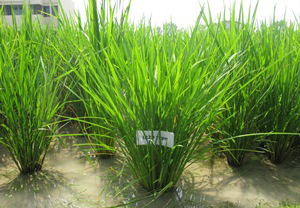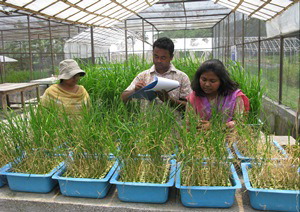The aim of the project was to identify, characterize and validate the salt tolerant determinants in the rice landrace Horkuch. This rice landrace is popular among farmers in the southwestern areas of coastal Bangladesh, known as Satkhira. This area is north of the Sundarbans and is known to be affected by salinity stress. The study used a reciprocal population derived from the tolerant Horkuch and sensitive IR29 to locate genetic loci segregating with tolerance and sensitivity. Application of NGS tools was considered the best and most sensitive approach to identify loci, their linked markers, and genes associated with tolerance to salinity. The following focus areas had been addressed by the time the project was completed at the end of May 2016:
Dr. Seraj and her team have completed at least seven papers on their work that they expect to submit for publication during the summer of 2016. The PI has also received two grants this year to help continue the work pursued with PEER funds. The first, for a project on “Validating role of the Drought and Salinity Tolerant (DST) Transcription Factor for a better understanding of high yields and abiotic stress tolerance mechanisms in two Bangladeshi rice varieties,” was awarded by the Third World Academy of Sciences. The second, from the Bangladesh Academy of Sciences and U.S. Department of Agriculture, Bangladesh Chapter (BAS-USDA), will support three years of work on “Development of high yielding abiotic stress tolerant rice by introducing Ideal Plant Architecture (IPA) into salt tolerant landrace and functional validation of introduced transgenes."
In summing up the overall results and impacts of her PEER funded work over the past 2.5 years, Dr. Seraj notes that “the mentorship of the U.S. partner has been excellent and has led to a standard of work for my lab which we were previously unable to reach (prior to PEER). We are hoping to publish seven research articles in prestigious international journals from this PEER grant. This will bring a tremendous boost to the reputation of Dhaka University. By the time that all the papers are published, we will hopefully be able to propose a mechanism for salt tolerance of the traditional landrace Horkuch. This will not only increase knowledge but also enhance our salinity tolerance breeding programs. Moreover it is envisaged that the output of this work will lead to salt tolerance breeding programs which will incorporate multiple salt tolerance QTLs in single progenies and hopefully produce greater tolerance levels.”
On the capacity building side, two of the research associates who worked under PEER are now PhD students under the supervision of the U.S. partner Dr. Juenger at the University of Texas at Austin (UTA). One of them, Samsad Razzaque, began his studies in the fall of 2015, and the other, Taslima Haque, will enroll in the fall of 2016. When the PEER project began, the third research associate, Sabrina Elias, was already in the Monsanto, Beachell, Borlaug International Scholar Program (MBBISP) pursuing her PhD under the University of Dhaka, UTA, and the University of Nebraska-Lincoln. Sabrina’s thesis will officially document the work under PEER as a record under the University of Dhaka. In addition, Sabrina will be visiting the International Rice Research Institute in October 2016, where she will be doing a comparative analysis of Horkuch with other salt tolerance donors like Pokkali and Nona Bokra under the guidance of Dr. Abdelbagi Ismail and Dr. Damien Platten. Dr. Seraj reports that there was a mutual benefit to both MBBISP and PEER under this project, as the PEER award allowed the sequence analysis of a big population, while the automated phenotyping done at UNL will help validate the results obtained from the PEER work.
PublicationsHaque, T., Elias, S.M., Razzaque, S. et al. 2022. Salt tolerance QTLs of an endemic rice landrace, Horkuch at seedling and reproductive stages.
Sci Rep 12, 17306 (2022).
https://doi.org/10.1038/s41598-022-21737-9Elias Sabrina M., Rahman M. Sazzadur, Khan Sumaiya F., Biswas Sudip, Haque Taslima, Razzaque Samsad, Seraj Zeba I. 2020. Combination of traits at two developmental stages under salt stress as a measure of tolerance in a reciprocally crossed rice (Oryza sativa) population.
Crop and Pasture Science 71, 334-348.
h
ttps://doi.org/10.1071/CP19560Razzaque, S., Elias, S.M., Haque, T. et al. 2019. Gene expression analysis associated with salt stress in a reciprocally crossed rice population.
Sci Rep 9, 8249 (2019).
https://doi.org/10.1038/s41598-019-44757-4.
Razzaque, S., Haque, T., Elias, S. et al. 2017. Reproductive stage physiological and transcriptional responses to salinity stress in reciprocal populations derived from tolerant (Horkuch) and susceptible (IR29) rice.
Sci Rep 7, 46138 (2017).
https://doi.org/10.1038/srep46138




